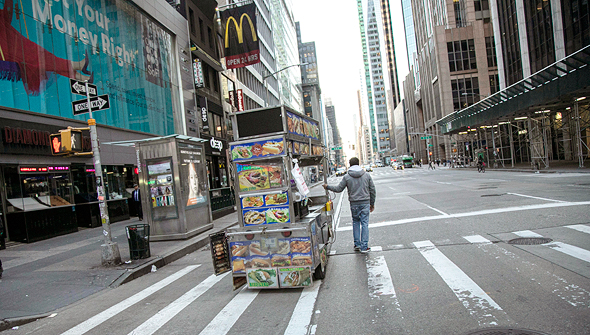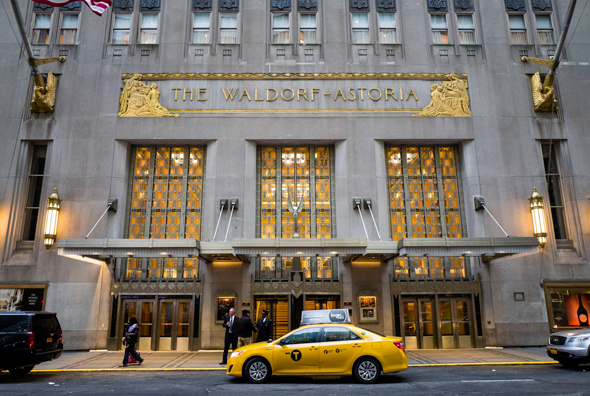Interview
"Investment opportunities will be slow to come along in 2020. We're in a marathon not a sprint to recovery"
DLA Piper senior partner Jay Epstien says creative and innovative leadership will be the main factors that determine companies' success in the post-Covid world
Jay Epstien, a Senior Partner at DLA Piper is in no rush to eulogize either shopping malls or office space, and believes that the Covid-19 crisis will push the nimble, thoughtful and adaptable developers to the front of the line. Epstien, who served as a founder and leader of the firm's Global Real Estate Department from 2005-2018, also dismisses the criticism being heard about investment funds taking control of retail chains in bankruptcy proceedings and firing employees. "Without their intervention, all the jobs might have been lost," he stressed in a special interview with Calcalist.
 Jay Epstein. Photo: Yisrael Hadari
Jay Epstein. Photo: Yisrael Hadari More than 40 retailers in the U.S. have filed for bankruptcy since the start of the year. What will happen to all the empty space?
"We are now seeing the acceleration of a process that began following the challenges posed by the rise in online commerce and demographic changes, with many retailers being slow to adapt to the seismic shift taking place. But the coronavirus has created a crisis on steroids and we are seeing many more bankruptcies than would otherwise have occurred. Of course different parts of the retail sector will experience this in different ways. Food and drug-store chains, for example, are maintaining stability, and shopping centers with anchor stores in these areas are in a relatively good place," Epstein said.
"We see retailers like Amazon rumored to be conducting talks with J.C. Penney and others in order to take control of these large stores and perhaps turn them into distribution centers. 14 million square feet of these anchor stores have already undergone a change of usage and become warehouses and logistics centers. One of the most important questions is how the rest of the space in those shopping centers will adapt to the likely change in customers and foot traffic," he explained
However, according to Epstien, the spaces won't only be converted into warehouses. "We worked on a mall in Texas where much of the space was converted into a community college. So there are other uses in play," he says.
If the virus hadn't broken out what would 2020 have looked like in the retail sector?
"In 2019 and the years preceding it, there were very many store closures and a lot of department stores disappeared from the landscape. In January 2020, some predictions were that the number of closures this year would be lower than last year, but of course that appears to be very unlikely. Separate and apart from the virus, the 30-year operating covenants signed by anchor tenants when regional malls came on the scene have expired in many places. As a result, many of these department stores have shut down. In addition to losing one the building blocks of a regional mall, anchor department store closures also trigger co-tenancy agreements that allow other stores to close or reduce rent if there are not enough active stores in the mall. This interdependence enables the strong retailers to demand lower rents or even termination options based on failed co-tenancy standards. It's an issue that has attracted much attention in the past two or three years with increasing amounts of store closures and now the virus has of course accelerated the trend to a scale that is hard to imagine."
"Victoria's Secret wants to get out of the contract"
"As would be expected in the U.S., much litigation has been filed – both with landlords seeking to enforce rent payment obligations and tenants challenging lease obligations on the basis of force majeure provisions in the leases. Two of the most interesting cases involve Victoria's Secret and Bath & Body Works and their stores in New York's Herold Square, just south of Times Square. They have sued their landlords, demanding that they be released from their contracts because they claim that they opened the stores on the understanding that there would be major shopping traffic on the streets of New York. And that has disappeared."
 An empty street in New York City. Photo: AP
An empty street in New York City. Photo: AP The takeover of Brooks Brothers by the Simon Property Group drew major criticism because the funds taking control of the retailer fired employees.
First and foremost, we are talking about creative behavior by these types of companies and Simon Property is of course at the forefront of innovation in the retail sector. Remember, the aim here is to preserve tenants (and, for example, not trigger a co-tenancy clause as we discussed earlier). There is a lot of risk here. While Simon of course knows how to lease space, their expertise is not operating stores. That is why they are working in cooperation with Authentic Brands, a retail operator. The issue of job loss, after the issue of health, is the biggest and most significant fallout from the virus. Our expectation in the U.S. is that the most (not all) of the job losses will come back slowly, and we are already seeing evidence of that. If Simon or someone else had not intervened in the Brooks Brothers bankruptcy process and bought the company, all the jobs might have been lost. They are saving jobs but they can't save 100% of them. This criticism is not justified."
What examples can you give of new uses for shopping malls?
"We will continue to see an expansion of mixed-use activities in malls and shopping centers. In some of them, residential buildings have been added in recent years. People want to be in a place where they can get food, entertainment and housing at the same time. New retail properties are being developed as mixed use projects in this way and existing ones are receiving approval to add apartments."
Where is this happening? Is it limited to certain U.S. states?
"It is happening throughout the U.S. In the post-coronavirus world, we are now talking about people wanting to leave the cities, reversing the urbanism trend that was dominant the past 5-7 years. They don't want to travel on public transportation or go into elevators in high-rise buildings. One of the most relevant considerations when people talk about new residential buildings is the walkability index. How close is the building to public transport, to food, to their place of work. There never were grocery stores in malls in the US but today Whole Foods, Fresh Market and others are moving into malls. The German chain (Lidl) opened in the Staten Island Mall last year."
"Five years ago, Santa Monica Place was a successful regional mall in a massive, enclosed building developed in the way that most malls were built in the U.S. It also was uniquely located close to the Pacific Ocean. What did they do? They ‘de-malled’ the property by removing the roof in the common areas, opened restaurants with a view of the ocean and the former mall became a completely repositioned, highly successful, open-air center."
What about hotels? What will happen to this sector in the coming year?
“Just like retail, they were hit hard and quickly. But here too you have to analyze the sector according to types of hotels. People travel more in cars so that limited service hotels on highways have begun to recover. The bigger challenge has been for large hotels in cities used for conferences. Nobody is holding conferences this year. On the other hand, luxury hotels in resort locations are coming back because people want to go on vacation. Hilton’s CEO recently predicted that it will take two to three years for a complete recovery. And there are those who say that is an optimistic forecast."
 The Waldorf Astoria in New York City. Photo: Getty Images
The Waldorf Astoria in New York City. Photo: Getty Images "If you ask people when New York City will look and behave like it did in January 2020, the forecasts range between five and ten years. But cities are resilient and they survive things like the virus—whether it's the black plague or the 9.11 terror attacks, cities do rebound. There is very good research that demonstrates that we are more productive when we are together. "It's impossible to build an organizational culture via remote working," said the CEO of a large investment advisor. And it is more difficult to be innovative when we are not sitting together. Zoom is wonderful but as lawyers, for example, it will be challenging to train young people when you are not sitting with them. Not for every minute but sometimes. There can be no doubt that the cities will bounce back – just a question of when."
Offices have shrunk in recent years
Office spaces also aren't going away, says Epstien. "One of the biggest discussions at the moment is if everybody will reduce office space. Although it is early to forecast, it looks like companies will need less space because some of the workforce will continue to work from home even as the world recovers from the virus.”
In the last five years, stresses Epstien, offices have in many cases shrunk around the world as they have become more compact to reduce costs and foster collaboration. However, it is more difficult to maintain social distance in a densified office environment. The combination of the new reality and emerging trends makes it difficult to forecast future demand. "There are also companies that won't return to New York because they don't want to endanger employees on public transport. Many of these companies will move to the suburbs.”
How many people will leave altogether?
“It's too early to say. Conda Nast recently announced that they want to be released from their contract for millions of square feet in one of the World Trade Center buildings. They were one of the first large tenants that moved there in 2014 from dozens of locations in the city, and now they want to leave (although perhaps remain in New York City). The problem is that it is not possible simply to get up and go because they have a long-term lease contract."
What about shared workspace offices? What will happen to that model now?
"WeWork has been the biggest renter in New York, Washington and London and they aren't going anywhere. There is no doubt that co-working/shared office spaces are here to stay. Moreover, one of the WeWork strategies in recent years was to focus on ‘enterprise’ solutions where they offered a company the chance to design and build for them the space without extra money and without needing to commit to a contract of 10 to 15 years. And that is still very attractive."
 WeWork offices in New York City. Photo: Shutterstock
WeWork offices in New York City. Photo: Shutterstock "Shared workspaces will still be very attractive for people that don't have enough technology at home and want to come to a workspace which has better broadband, and better printing. WeWork's new CEO Sandeep Mathrani is a brilliant guy with much experience in re-positioning companies. Many shared workspace office companies are now conducting negotiations in an effort to give back spaces and WeWork, like its competitors, will certainly shed some locations.. Whether or not co-working companies remain among the largest tenants in some of the major cities I don't think that the concept will disappear. The co-working industry changed the way that people relate to workspaces, and it’s unlikely that the pendulum will shift all the way back."
Epstien highlighted the adaptation process that Convene underwent in the post-covid world. Convene started as a company that would lease conference rooms for meetings of all sizes. "They began nine years ago, and they operate in large US cities and London. Of course, now nobody wants to hold large meetings but Convene pivoted to market themselves as a Zoom-style platform that can organize, for example, a conference for 1,000 people, Large-scale meetings, even via webinar, are no simple matter to organize and orchestrate. Convene is a great example of an innovative company led by a brilliant entrepreneur."
Working from home has sent many Americans looking for houses in the suburbs. How does the market look at the moment?
"The millennials that wanted to live in the cities, got married, had children and now want to leave the cities for more space. That was the trend before the virus. Now it is certainly happening. Many of my colleagues who live in the suburbs –such as Westchester County outside of New York City and Montgomery County outside of Washington DC—have put their homes up for sale because it's clear that people want them. But, the prospective buyers are finding it difficult because of limited supply. One of my daughters has been looking for a house for some time, but due to the limited supply the moment a house comes on to market the bidding wars begin (and it’s not unique to Washington, DC). Two or three years ago, nobody wanted homes in the suburbs and those that were built in the countryside. But today there is new life for these homes for whoever can afford them.
"It’s also important to recognize the big challenge for people working from home with children in ‘virtual school.’ Not only do they face difficult issues in balancing the demands of work and home-schooling, they also face great uncertainty about how they will return to their offices at the appropriate time when their children may continue in virtual school for the foreseeable future."
The luxury apartment market in New York is under great stress
According to Epstien, the biggest U.S. cities are the ones facing the biggest challenges at the moment because of high-rise buildings with elevators and public transportation. "A real estate agent in New York City told me that the market for expensive apartments in the city, $4 million and upwards, is simply dead. People who have large apartments in New York are selling them and moving to their country houses and saying that they are never coming back.
 New Yorkers riding the subway. Photo: AP
New Yorkers riding the subway. Photo: AP “Remember that public transportation in New York was not only used by blue collar workers and professional support staff, but that most everybody once used the subway to get to work. This is a very large challenge in places like New York, Boston and Chicago, to name just a few. A place like Los Angeles is recovering faster because it's a city of cars compared with Washington where there is a significant dependency on public transportation."
What Investment opportunities will be out there?
On the investment front, Epstien singles out office buildings in New York and other major hubs that will come back as an especially attractive target, but stresses that the opportunities are not yet there because there is still too large a gap between sellers and buyers' expectations. "The bottom line for those who have an historical perspective and know how to be opportunistic and look beyond this mess, there will be real estate opportunities. Many investors will have a very, very successful time. Maybe not in 2020, but we are not talking about a sprint but rather a half-marathon or marathon."



